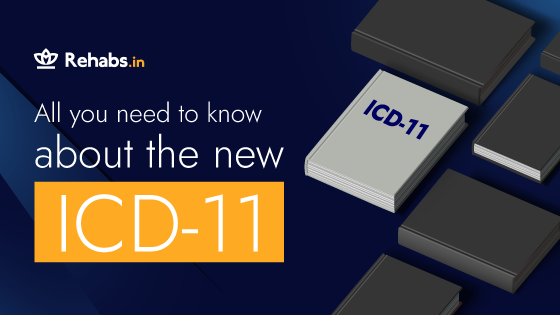All about the new ICD-11

What is ICD and the changes in the 11th edition
Most professions have some kind of reference guide that aids them in doing their job better and helps them keep up with the changes in their professions. Lawyers would refer to law books and official government websites to learn about updates to new laws. Architects would similarly want to learn about new practices and rules, especially those related to the environment. In the same manner, one of the reference guides medical practitioners refer to is the International Classification of Diseases (ICD). It helps them identify and diagnose physical and mental ailments.
The ICD is a diagnostic tool that is used to catalogue, monitor and study causes of mortality (death) and morbidity (illness) trends. It was created to encourage international compatibility in health data collecting and reporting.
Brief history of ICD
Attempts to classify diseases began as early as the 1600s, however, they were often inconsistent due to poor statistical data. Over two centuries later the International Statistical Institute approved the first international classification of diseases in 1893 which was based on the Bertillon Classification of Causes of Death, developed by French statistician and demographer Jacques Bertillon. Over time, Bertillon’s classification came to be known as the International List of Causes of Death and eventually as the ICD.
In 1948, the World Health Organization (WHO) took up the responsibility for publishing the ICD and started gathering international data for all general epidemiological investigation and health management purposes. WHO made significant revisions to the ICD in the 1980s and early 1990s. This resulted in a three-volume work, known as ICD-10 (International Statistical Classification of Diseases and Related Health Problems), and was published in 1992 replacing the two-volume ICD-9. The latest version of the ICD, ICD-11, was approved by the 72nd World Health Assembly in 2019 and came into effect on 1st January 2022.
The shift from ICD – 10 to ICD- 11
The 10th edition of ICD was published 30 years back. Since then, medical knowledge and understanding of diseases have advanced significantly. A simple update could not accommodate three decades worth of changes in the medical field. The other reason for the major overhaul to the 11th edition is the advent of the digital era. Although ICD-10 was being used in digital forms, properties that reflect its pre-digital origin inhibited tooling and data exchange, hindered maintenance and development, and caused differences of structure and meaning to crop up into translations and modifications.
The 11th edition was developed through a unique collaborative process where experts and users were asked by WHO to participate in the revision process through a web-based platform. The revision process took a decade and involved 300 specialists divided into 30 workgroups across 55 countries who provided input. Health care workers too attended collaborative meetings to integrate practical applications in the ICD-11 revision in addition to theoretical concepts, chiefly in the area of mental health. The resulting changes in the 11th edition are now quite extensive. ICD-11 is a more intuitive health information system, built on formal ontology, designed to be applied through digital ecosystems, and flexible enough to accommodate future modification, classifications and terminologies.
Improvements in the ICD-11
Enhancements implemented in the ICD-11 bridges the gaps in the ICD-10 and include medical updates and discoveries, as well as changes in opinions and thoughts in the social setting (e.g., views on homosexuals). Important revisions have been made to ICD-11 in terms of the method of categorization and coding structure, international usage, digital-ability, and use-accessibility. ICD-11 has around 55,000 codes that can be used to classify diseases, disorders, injuries, and causes of death.
The following diagnoses are now a part of the ICD-11:
Attention Deficit Hyperactivity Disorder (ADHD): ADHD is defined as a persistent pattern (6 months minimum) of inattention and/or hyperactivity-impulsivity that has a direct undesirable effect on academic, professional, or social functioning. ADHD is observed in children prior to age 12 though many seek treatment much later in life.
Complex PTSD (Complex post-traumatic stress disorder): Complex PTSD is a disorder that can develop after exposure to prolonged or repetitive events of traumatic nature from which escape is difficult (e.g., torture, slavery, genocide campaigns, lifelong domestic exploitation, repeated childhood sexual or physical abuse).
Compulsive Sexual Behavior Disorder (CSBD): CSBD can be defined as a constant inability or complete failure to control intense, repetitive sexual impulses or urges resulting in repetitive sexual behaviour. CSBD can have a negative impact on a person’s professional, social and personal relationships.
Gaming Disorder: Gaming disorder is characterized by a pattern of insistent or recurrent gaming behaviour (especially addiction to online gaming and video games). The pattern of gaming behaviour can be constant or episodic and recurrent. The disorder can cause a negative impact on the personal, social, family life of the gamer. The disorder can also cause a person to fare poorly in education, professional and other significant areas of life.
Prolonged Grief Disorder: Prolonged grief disorder occurs after the death of a partner, spouse, parent, child, friend or another person especially close to the bereaved. There is a continuous and inescapable grief response characterized by intense longing for the deceased person and accompanied by strong emotional pain (e.g., sadness, denial, guilt, anger, blame, emotional numbness, trouble in maintaining social or personal relationships). The grief response surpasses the normal social, cultural or religious time frame and lasts for more than 6 months at a minimum.
The following disorders were removed from the ICD-11.
Acute Stress Disorder: Acute stress disorder is a psychiatric diagnosis that may develop in patients within a frame of four weeks of a traumatic event. Some of the signs can include anxiety, helplessness, intense terror, dissociative symptoms, reexperiencing the event, and avoidance behaviours.
Gender Incongruence: Gender incongruence refers to an individual’s dissatisfaction or nonacceptance of their assigned gender and the identification with a gender other than that of their birth sex. The ‘dysphoria’ relates to the psychological distress that arises from not being able to relate to one’s assigned gender.
Personality Disorders: A personality disorder is a kind of mental disorder in which a person has an inflexible and unhealthy way of thinking, functioning and behaving and deviates from social and cultural expectations. This pattern of thinking can negatively impact a person’s social, occupational and personal life.
Within the ICD-11, each mental, behavioural, and neurodevelopmental disorder is listed with a guided description. The following disorders are currently included in the ICD-11:
· Anxiety or fear-related disorders
· Catatonia
· Disorders of bodily distress or bodily experience
· Disorders due to substance use or addictive behaviours
· Disorders specifically associated with stress
· Disruptive behaviour or dissocial disorders
· Dissociative disorders
· Elimination disorders
· Factitious disorders
· Feeding or eating disorders
· Impulse control disorders
· Mental or behavioural disorders associated with pregnancy, childbirth and the puerperium
· Mood disorders
· Neurocognitive disorders
· Neurodevelopmental disorders
· Obsessive-compulsive or related disorders
· Paraphilic disorders
· Personality disorders and related traits
· Schizophrenia or other primary psychotic disorders
To help with the ease of transition from ICD-10 to ICD-11, the following components are included in the implementation package: Coding tool, Manual, Training material, Transition tables from ICD-10 to ICD-11, Translation tool and Web services. These tools are available to users who register on the ICD-11 platform online.
ICD-11 vs. DSM-5
DSM stands for Diagnostic and Statistical Manual of Mental Disorders. The ICD-11 and DSM-5 are identical in some ways and differ in others. Both are authoritative guidebooks for medical experts to refer to for the diagnosis and treatment of diseases and disorders. ICD includes diagnoses for the whole body and mind while DSM only focuses on mental health problems. So, when it comes to mental health there is quite an overlap of information.
The latest version of the DSM was published on 18th May 2013, by the American Psychiatric Association (APA). Compared to the DSM-5, the ICD-11 is more extensive both in its scope and its authorship. ICD-11 is adopted by many nations around the world whereas DSM-5 is an official classification in the United States. Another important difference is that the DSM does not code its diagnoses. Mental health professionals in the United States mainly use the DSM for diagnosis but depend on the ICD codes for insurance billing purposes; however, codes in DSM-5 are not valid ICD codes. This may cause a misunderstanding when an ailment is classified differently (or not at all) from one manual to the other. To alleviate this problem, the WHO and the American Psychiatric Association (APA) are working together to harmonize the structures of the DSM-5 and ICD-11.
ICD is widespread in WHO member nations which include low and middle-income nations whereas DSM is the foremost choice for psychiatric health in high-income nations. ICD offers guidance and diagnostic criteria but it does not include operational criteria. DSM offers operational criteria with distinct definitions for each condition. Lastly, there are precise variances in the manner with which different disorders are treated between the two bodies of categorization. For e.g., attention-deficit hyperactivity disorder (ADHD) has only just been added to the ICD-11 (ADHD was not in the ICD-10), whereas it has long been diagnosed in the United States according to the DSM-5.
In conclusion, the new ICD-11 can positively influence or amend the standards for the diagnosis and classification of diseases. It is a move in the right direction as the latest edition is in line with the current research trends and focuses on improvement rather than just emphasizing the presence or absence of a disorder. Moreover, it has caught up to the 21st century and has now everything on a digital platform.
Sources
Raminani, S., International Classification of Diseases. https://www.britannica.com/
https://www.britannica.com/topic/International-Classification-of-Diseases
International Statistical Classification of Diseases and Related Health Problems (ICD) https://www.who.int/
https://www.who.int/standards/classifications/classification-of-diseases
Harrison, J., Weber, S., Jakob, R., Chute, C. (2021, Nov) ICD-11: an international classification of diseases for the twenty-first century.
https://bmcmedinformdecismak.biomedcentral.com/articles/10.1186/s12911-021-01534-6
FAQs for ICD-11
https://www.who.int/classifications/icd/revision/icd11faqs.pdf
Arlin Cuncic, A., Carly Snyder, C. (2020, Sep) What Is the ICD-11? https://www.verywellmind.com/
https://www.verywellmind.com/overview-of-the-icd-11-4589392
ICD VS DSM – Key Differences and Similarities. https://www.flatworldsolutions.com/
Ajiboye, T. (2019, Oct) 3 Major Changes to Look for with ICD-11. https://www.simplepractice.com/
https://www.simplepractice.com/blog/3-major-changes-to-look-for-with-icd-11/
Legg, T., Kivi, R. (2018, Sep) Acute Stress Disorder. https://www.healthline.com/
https://www.healthline.com/health/acute-stress-disorder
Butler, G. (2020, Dec) Gender incongruence. https://www.sciencedirect.com/
Personality disorders. https://www.mayoclinic.org/
https://www.mayoclinic.org/diseases-conditions/personality-disorders/symptoms-causes/syc-20354463
ICD-11 for Mortality and Morbidity Statistics
https://icd.who.int/browse11/l-m/en















